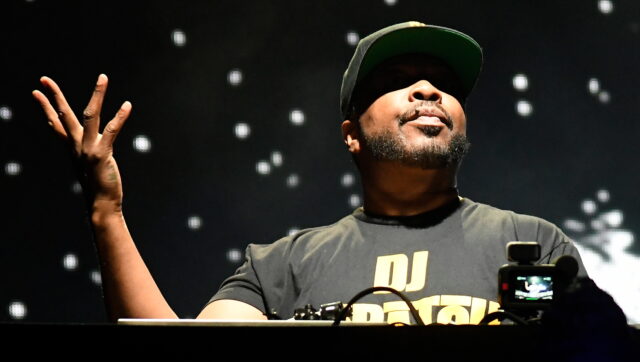How Donald Byrd & the Mizell Brothers Built the Future
Derided by white critics as sellout fodder upon release, the trumpeter’s 1973 LP Black Byrd impacted generations of great Black music — from golden-age hip-hop to jazz’s vibey, atmospheric state of the art.
by Nate Chinen
Famously, it begins with a jet taking off — the roar of a Boeing 707, to be precise, from a compilation of sound effects. This is “Flight Time,” the opening cut of Donald Byrd’s Black Byrd, which Blue Note Records released in February of 1973. The album marked a turning point for Byrd, a trumpeter who’d made his name along the forward edge of hard bop, as well as for Blue Note, which broke into a new jazz-funk crossover era with the Mizell Brothers as producers. Fifty years later, it’s easier to see how Black Byrd was not just pivotal but also prescient. The album holds a blueprint for the sonic architecture of so much on our present-day, vibes-forward scene. And it achieved this despite a history of indifference or open hostility from the critical establishment — a bit of turbulence, as it were, on the way to cruising altitude.
Byrd in Flight was the title of a previous Byrd album on Blue Note, released at the dawn of the ’60s, with a punchy, Jazz Messengers-esque sound and pedigree. Black Byrd — written in its entirety by Larry Mizell, whose brother Fonce had studied with Byrd at Howard University — suggests a different order of aeronautics. The album derives its funkiness through terse syncopation and silky restraint: “Flight Time” sets the tone with a metronomic groove, set up by what sounds like a beeping alert on a pilot’s console. The title track rides another cooled-out funk beat, beneath a murmured vocal part and a soft-staccato riff for flute and flugelhorn. Byrd isn’t struggling to get airborne at any point on this album; he’s already in an easy, arcing glide.
That laidback mood and layered construction help explain why, even though it arrived on the front end of fusion’s watershed year, Black Byrd isn’t usually discussed in those terms. It’s neither as questing and incandescent as the Mahavishnu Orchestra’s Birds of Fire, nor as vaultingly heroic as Return to Forever’s Hymn of the Seventh Galaxy. You don’t picture it bulging out of a sweaty muscle tee, like Billy Cobham’s Spectrum, or doing calisthenics in a jumpsuit, like Weather Report’s Sweetnighter. Its closest cousin is Herbie Hancock’s Head Hunters, which arrived later in 1973, with similar DNA. But Black Byrd is a smoother ride, with every syncopation rounded at the edges, every solo oozing soul. More than any of the spectacular touchstones named above, it just … feels good. That this basic quality could be judged so differently says a lot about who’s doing the listening, and to what purposes.
Consider the album’s reception in the jazz press. Byrd was a big name making big moves, but DownBeat didn’t cover Black Byrd — except to lump it in with a follow-up, Street Lady, later that year. “Donald Byrd isn’t making these albums because he can’t do anything better; it’s a matter of choice,” complained Neil Tesser in a two-star review. “The repetitive rhythms, hackneyed harmonies and unoriginal melodies are musically vapid, and yet Byrd has that Mizell touch that turns everything, if not to gold, then at least to substantial sales and position on the charts.”
On that last point, Tesser was simply stating facts. An article in the June 23 issue of Billboard cited the title track of Black Byrd as a test case for record labels pitching a jazz album cut like a Top 40 single — the result being that the album became “the biggest seller in Blue Note history, with over twice as many units sold as the nearest runner-up.” A month later, a piece in JET magazine noted that “Black Byrd not only set a new sales record for the Blue Note label, but sold over 100,000 units within six weeks of its release.” No surprise that when Byrd made his stage introduction that summer, during a concert now available as Live: Cookin’ With Blue Note at Montreux, he made a point of casually mentioning “my latest hit album, a thing entitled Black Byrd.”

Jazz history is rife with examples of hand-wringing skepticism over a lauded artist who reroutes their music in the service of a more accessible ideal: Think of Louis Armstrong (with his All-Stars) or Miles Davis (after the late ’60s) or George Benson (ditto). What complicates this reading of Byrd, among others, is the vector of race: the fact that his harshest critics were almost uniformly white, and his successes came among an audience that was mostly Black.
For such an audience, the commingling of jazz with R&B and soul was a feature, not a bug. When Ebony magazine ran its first Black Music Poll in the fall of 1973 — a genre-agnostic exercise, but one with a culturally specific point of view — Black Byrd emerged as Jazz Album of the Year. Byrd came in at No. 2 for Artist of the Year, between Quincy Jones (No. 1) and Cannonball Adderley (No. 3). In the Trumpet category, Byrd ranked just behind Miles Davis and Dizzy Gillespie. The readers of Ebony weren’t fretting about his squandered potential.
Some of them had surely picked up on the album’s abundant signifiers of Blackness — beginning with a cover design featuring the colors of the Pan-African flag and an arresting photogravure from 1897, caricaturing a ragtime band at a dance. Larry and Fonce Mizell were coming off a hot streak at Motown; they’d just created a new production company, Sky High, which also provided the title and lyrical hook of a tune on the album’s Side B. Here and elsewhere on Black Byrd, the vocals are approachable even when the Mizells are harmonizing; it’s easy to sing along. And who else but a streetwise Larry Mizell would include a take on “Slop Jar Blues,” which had appeared the previous year on an album produced by Rudy Ray Moore, the profane comedian known as Dolemite? (That album’s title? What a Big Piece of Meat!)
Personnel-wise, the album features not only Byrd’s accomplished peers — like drummer Harvey Mason Sr. and a few members of the Crusaders, notably keyboardist Joe Sample — but also some of his students at Howard, like pianist Kevin Toney. Those younger players soon formed a smooth-R&B spinoff project, the Blackbyrds, with Byrd as producer; they scored a handful of hit singles, like “Walking in Rhythm,” and had a long afterlife in hip-hop, sampled in the music of De La Soul, Tupac Shakur, N.W.A, Nas, Wiz Khalifa and more. (You could spend an afternoon tracing the sample trail of “Rock Creek Park,” which opens the band’s 1975 album City Life.)
All this context, musical and cultural, bolsters the idea that Black Byrd resonates with our own jazz moment. The balance of Black pride and coded play can be found in much of the music created or otherwise coddled by Robert Glasper, and on any number of releases on the International Anthem label. The sleek yet assertive economy that Byrd exhibits on the album — distinct from more pugnacious stances of peers like Miles Davis and Freddie Hubbard — has a parallel in present-day trumpeters like Keyon Harrold and Theo Croker. Check out Live: Cookin’ With Blue Note at Montreux, which dials up the album’s intensity, and you might even think of the West Coast Get Down, Kamasi Washington’s crew. (The connection is most obvious on a tune titled “Kwame,” which isn’t on Black Byrd — but give it a listen and see if you don’t agree.)
There’s one more hidden portal worth considering. That metronomic early section of “Flight Time” was sampled for two of the cornerstone tracks in hip-hop history: Public Enemy’s “Fear of a Black Planet” (1990), produced by the Bomb Squad; and Nas’ “N.Y. State of Mind” (’94), with production by DJ Premier. More than a piece of trivia, this distinction closes a kind of circuit. At the end of Black Byrd comes a tune called “Where Are We Going?” — a prod in the same wheelhouse as Marvin Gaye’s “What’s Going On.” As Byrd solos in flurries atop the track, the Mizells voice their rhetorical question: “Where are we going?” Byrd himself adds another query: “And what’s the future showin’?” There’s no way to go down that road, metaphorically speaking, but in the most literal interpretation, it brought us here.



